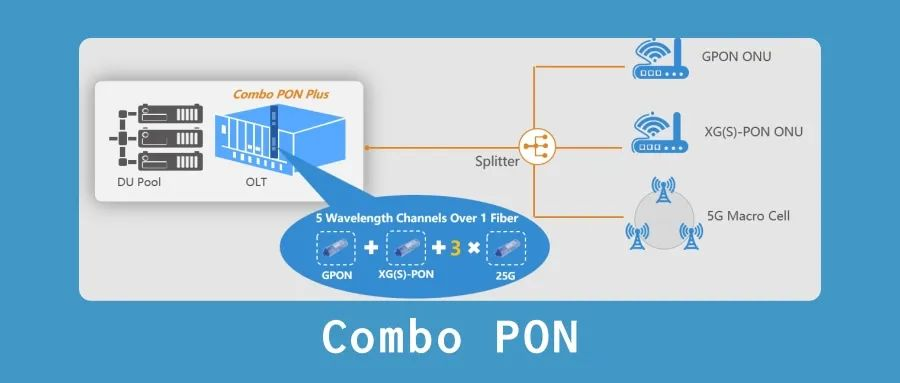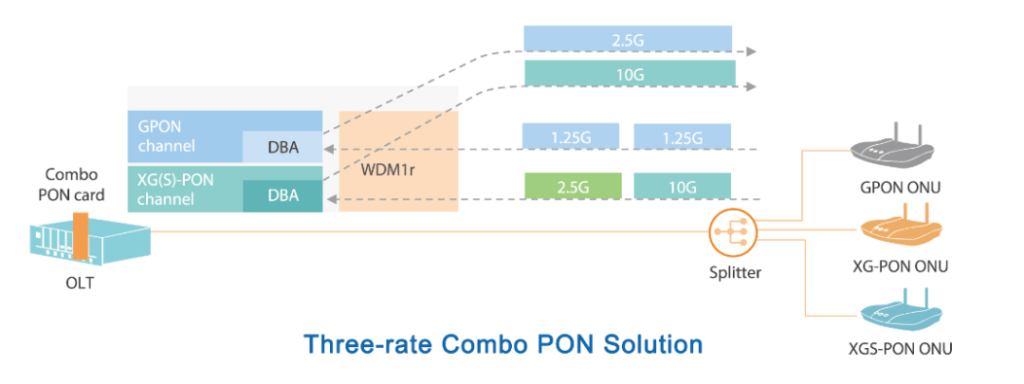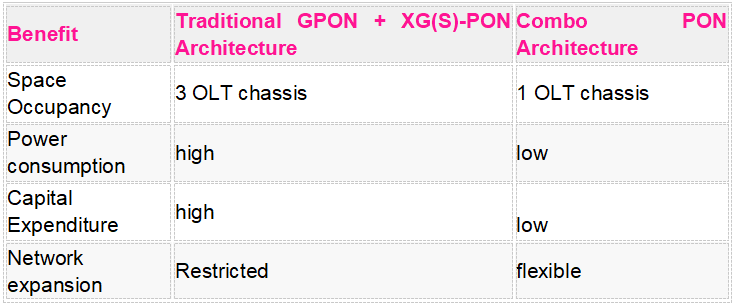With the rapid development of fiber-to-the-home (FTTH) network technology, GPON (Gigabit Passive Optical Network) has become the standard choice for most Internet service providers (ISP) around the world. However, as users’ demand for higher bandwidth, symmetrical rate and lower latency continues to increase, XG(S)-PON (10G passive optical network) has gradually attracted attention as the next generation of fiber access technology. In this context, Combo PON technology came into being. It efficiently integrates GPON and XG(S)-PON network technologies to help ISPs smoothly transition to higher-performance networks while meeting existing needs.

Combo PON
Combo PON is a solution that integrates GPON and XG(S)-PON network technologies, allowing both to operate simultaneously on the same optical distribution network (ODN). Traditional GPON technology provides 2.5Gbps downstream and 1.25Gbps upstream bandwidth, while XG(S)-PON can provide symmetrical 10Gbps upstream and downstream rates. The core advantage of Combo PON technology is that it can transmit these two technologies through the same optical fiber without introducing additional external coexistence modules, thus greatly simplifying the network structure.
Table of Contents
ToggleHow Combo PON works
Combo PON supports both GPON and XG(S)-PON MAC layers on the optical line terminal (OLT) port and combines the signals of these two technologies onto the same optical fiber through an optical combiner. This means that both newly deployed networks and existing GPON networks can run both technologies simultaneously through a Combo PON module without the need for additional wavelength coexistence modules.
In actual operation, the GPON and XG(S)-PON signals transmitted by Combo PON through the optical distribution network are received and processed by different ONUs (optical network units). GPON ONU can only receive and process GPON signals, while XG(S)-PON ONU is responsible for processing XG(S)-PON signals with higher bandwidth. In this way, Combo PON can achieve the coexistence of multiple rates on the same physical infrastructure without affecting the user’s network experience.

Three-rate Combo PON Solution
The differences between Combo PON, GPON and XG-PON
Transfer rate
GPON: Provides transmission rates of 2.5 Gbps downstream and 1.25 Gbps upstream.
XG-PON: Significantly improved the transmission rate, with the downstream rate reaching 10 Gbps and the upstream rate reaching 2.5 Gbps.
Combo PON: By integrating GPON and XG-PON technologies, Combo PON can support two rates at the same time, GPON’s 2.5 Gbps/1.25 Gbps and XG-PON’s 10 Gbps/2.5 Gbps.
Wavelength utilization
GPON: Use an upstream wavelength of 1310nm and a downstream wavelength of 1490nm.
XG-PON: Use an upstream wavelength of 1270nm and a downstream wavelength of 1577nm.
Combo PON: Combo PON can achieve single-fiber four-wavelength transmission on the same optical fiber through built-in WDM (wavelength division multiplexing) devices, supporting independent transmission and reception of GPON and XG-PON.
Compatibility
GPON: As an early technology, GPON has been widely used around the world, and its equipment and technology are relatively mature.
XG-PON: As an upgraded version of GPON, XG-PON can coexist with the existing GPON network and support smooth transition.
Combo PON: By integrating GPON and XG-PON technologies, Combo PON is not only compatible with the existing GPON network, but also can provide high-bandwidth services on demand, achieving smooth network upgrades.
Cost
GPON: The cost of GPON equipment is relatively low and suitable for large-scale deployment due to the mature technology.
XG-PON: Although the cost of XG-PON equipment is relatively high, its high bandwidth and high performance give it a great advantage in future network upgrades.
Combo PON: Combo PON equipment is more expensive, but it can reduce the overall upgrade cost by being compatible with existing networks and providing high-bandwidth services.
Application Scenario
GPON: Mainly used for services such as home broadband access, IP telephone and digital TV.
XG-PON: Suitable for scenarios that require higher bandwidth, such as enterprise networks, data center interconnections, and high-bandwidth home users.
Combo PON:Applicable to scenarios that require compatibility with existing GPON networks and the provision of high-bandwidth services, and is particularly suitable for ISPs to carry out smooth upgrades based on existing networks.
The first generation of XG(S)-PON technology requires additional external coexistence modules (CEx modules) to combine GPON and XG(S)-PON signals on the same fiber, while Combo PON does not require these external devices. This makes Combo PON deployment easier and reduces optical power loss. In addition, Combo PON can support MAC processing of both GPON and XG(S)-PON through one OLT port, greatly improving the integration and scalability of the network.
Economic Benefits of Combo PON
Combo PON technology not only realizes the efficient integration of GPON and XG(S)-PON at the technical level, but also brings significant cost benefits to ISPs at the economic level. Combo PON provides a cost-effective solution for ISPs by reducing the amount of equipment, lowering energy consumption and reducing capital expenditures.
Cost-effectiveness

Energy-saving benefits
Since Combo PON reduces the number of OLT devices required, it not only reduces the physical space occupied, but also significantly reduces power consumption. Less equipment running means lower cooling requirements, further reducing data center operating costs and carbon emissions. In addition, since Combo PON does not require external coexistence modules, eliminating the optical power loss introduced by these modules, ISPs can use a higher optical power budget to cover a wider service area, improving the service capabilities of the network.
Reduced capital expenditure
By integrating GPON and XG(S)-PON technologies, Combo PON eliminates the need for ISPs to deploy two independent OLT systems. This not only reduces equipment procurement costs, but also simplifies network operation and maintenance management, reducing long-term operating costs. At the same time, Combo PON supports automatic inheritance of the configuration of existing GPON services, avoiding duplicate configuration and user-side interference, further reducing the ISPs’ operational burden.
Traditional GPON and XG(S)-PON hybrid network architectures usually require separate OLT systems and external coexistence modules, which increases operators’ equipment costs and space occupation. In contrast, Combo PON significantly reduces the equipment footprint and power consumption by integrating GPON and XG(S)-PON in the same OLT module.
According to Adtran’s research, by upgrading to XG(S)-PON in a GPON network with 20,000 users, Combo PON can help service providers reduce rack space by up to 75%, reduce power consumption by 66%, and reduce capital expenditures by 50%. For ISPs building new or upgrading existing GPON networks, Combo PON can significantly reduce the total cost of network construction.
Combo PON Application Scenarios
Due to its combination of technical and economic benefits, Combo PON performs well in multiple application scenarios, especially in new network construction, existing network upgrades and high-bandwidth business scenarios.
New FTTH network
In the scenario of building new fiber-to-the-home (FTTH) networks, Combo PON provides ISPs with a more flexible deployment solution. ISPs can choose to first deploy GPON to provide entry-level services such as 100Mbps, and then upgrade to XG(S)-PON as user demand increases, thereby providing users with 10Gbps high-speed broadband services. This flexibility not only improves the long-term scalability of the network, but also helps operators save initial network construction costs.
Existing GPON network upgrade
For service providers who have already deployed GPON networks, Combo PON provides a smooth upgrade path. By introducing XG(S)-PON technology on the existing GPON network, ISPs can provide higher bandwidth services without changing the ODN structure. This upgrade process does not require additional home visits or user-side equipment replacement, greatly reducing the complexity and cost of the upgrade.
Enterprise and home broadband services
Combo PON also has significant advantages in supporting multi-service integration. ISPs can use GPON to provide 100Mbps broadband services for ordinary home users, while using XG(S)-PON to provide enterprise users with higher bandwidth and lower latency dedicated line services. This multi-service coexistence capability helps ISPs improve service flexibility and market competitiveness.
Smart City and IoT Applications
In the application scenarios of smart cities and the Internet of Things, Combo PON can support the access of a large number of smart devices and real-time data transmission with its high bandwidth and low latency characteristics. ISPs can use Combo PON to provide efficient and stable network support to meet the needs of various intelligent applications without changing the existing infrastructure.
Conclusion
Combo PON integrates two generations of PON technologies (such as GPON and XG-PON) into one single board and optical transceiver to achieve compatibility between the two PON technologies. By combining optical signals of different wavelengths in one optical transceiver, Combo PON can support independent transmission and reception of GPON and 10G PON at the same time. This is not only compatible with the existing GPON network, but also can provide high-bandwidth services on demand, achieving smooth network upgrades.
Combo PON uses the principle of different carrying wavelengths to combine two wavelengths in one optical transceiver to achieve independent sending and receiving processing of GPON and 10G PON optical signals. Specifically, GPON uses an upstream wavelength of 1310nm and a downstream wavelength of 1490nm, while XG-PON uses an upstream wavelength of 1270nm and a downstream wavelength of 1577nm. Through built-in WDM (wavelength division multiplexing) devices, Combo PON can achieve single-fiber four-wavelength transmission on the same optical fiber.
Combo PON has been technically verified and commercially piloted in multiple ISP networks. For example, ZTE’s Combo PON solution has been successfully applied in the existing networks of China Telecom and China Unicom. This solution not only improves the bandwidth utilization of the network, but also reduces the operator’s investment cost and the difficulty of engineering transformation.
